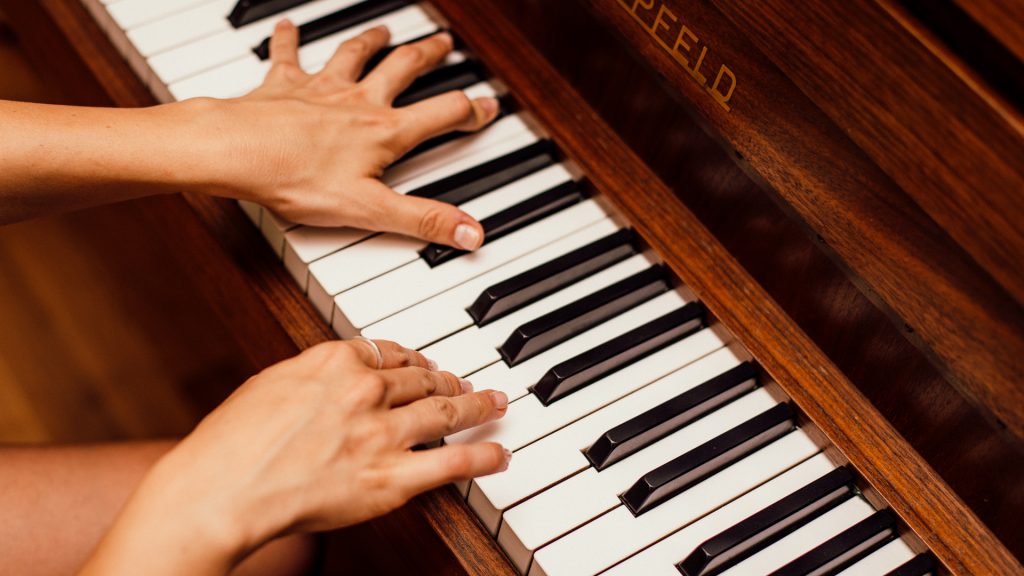Perhaps you once heard the story that the piano is an instrument that can be played by anyone because its notated score is the easiest to learn. This is true, to some degree. No musical education is required to learn to play Chopin, Mozart, or Beethoven. But to learn to play the same pieces, again and again, requires skill, commitment, and patience. And because the pieces are notated, you don’t have to think about the notes. You can only think about the keys. You are probably wondering “How long does it take to learn piano?” Well, that also depends, like previously stated, you can learn the songs, but to keep at them and do it without checking the sheet or pausing, takes skill and determination.
Like all musical instruments, pianos are machines, and like all machines, they can be broken down into basic parts and functions. The mechanism of a piano consists of a hammer, a string, and a soundboard. The soundboard is a large sheet of layered wood that vibrates in response to the hammer hitting the strings and produces the sound we hear.
Components of a Piano
The piano is an incredibly versatile instrument that can produce the most beautiful music found anywhere in the world. However, if you have never played, you have probably seen a piano in a music store and wondered what all the various parts are for.
The piano is a musical instrument that has been around since the 16th Century. It is a versatile instrument with many uses, such as playing instruments like the violin and flute. But what is actually in a piano? The piano comprises over 70 components, and to make a piano, and you need action, strings, and a soundboard.
The term “piano” is derived from the Italian word “piano,” meaning “high.” Thus, a piano is a high-pitched musical instrument – a harpsichord with up to 36 strings is a typical piano. In the past, the piano was a large box with a hammer and a keyboard on top, but today pianos have been miniaturised to fit in your pocket, and most have a set of 88 keys. A piano can have a wooden frame, a wooden shell, or be made entirely of plastic. Also, most pianos can be seen accompanied by piano benches or stools on which one can sit and play the instrument.
How do Pianos Work?
To learn about how pianos work, start by considering the physical qualities that make them sound good. They are made of two parts: the strings that run up and down the length of the piano and the hammers that strike the keys.
A piano is an instrument that makes a sound when you press keys on the keyboard. All pianos have strings running through them, but not all strings are used to make a sound. The keys on the piano are used to press the strings to make them sound. The strings are made up of metal, making them very hard, and because they are hard, they can hold the sound.
The sound of a piano comes from the strings’ vibrations, and its pitch is determined by the length and tension of the strings. When you strike a key on a piano, the key does not make any sound until the hammer strikes the strings and vibrates, causing them to vibrate, thus creating sound waves.
How the piano was invented
Your keyboard is an inanimate object, but the fact remains–it’s pretty complicated. Over the last few thousand years, we’ve come a long way from the first keyboard, the “clavichord,” which had strings running over a frame and was played by plucking with a bow. You could bet that the first “piano” was a mechanical device, and it came along around 1700, but it was nothing like the modern piano.
How the piano was invented is a question that has long puzzled historians, musicians, and scientists alike. Before the 19th century, it was commonly believed that the piano was invented in the days of Ancient Greece, where it was used by musicians to play songs for the gods. There are even drawings of the instrument dating back to this time, showing it as a large box with three rows of keys. However, the earliest known written description of it came much later, in the late 1600s, when Marin Mersenne published his treatise on the “invention of the touch.”
Conclusion:
In conclusion, the piano has been a multi-purpose instrument that has seen its share of ups and downs. The piano is an instrument that has been used to play many genres of music and is one of the most common instruments in the world. It has been a staple in western culture for over 200 years, and it will continue to be a popular instrument for many more years.

